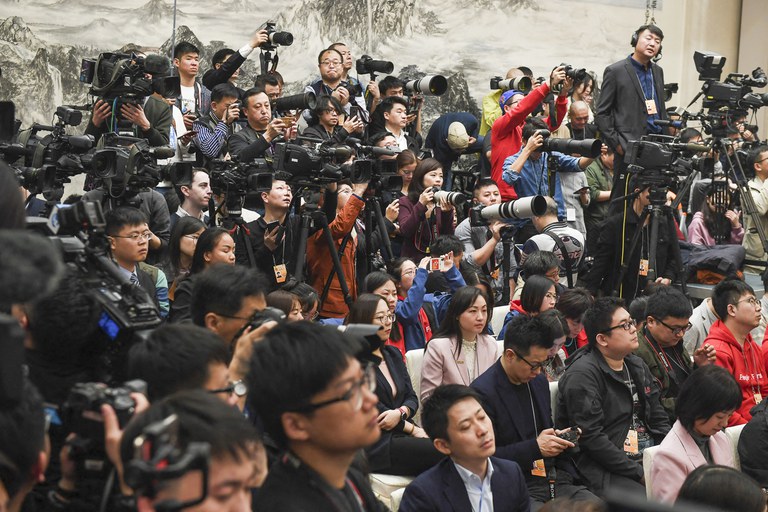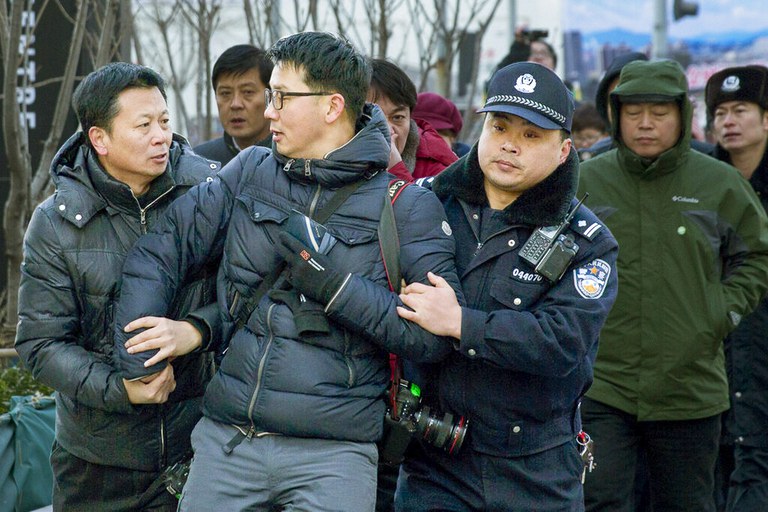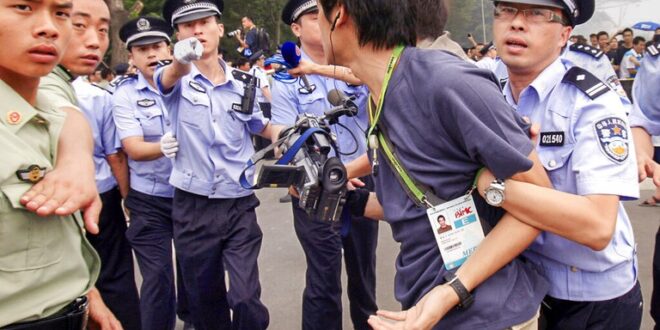Chinese authorities use drones to monitor and follow foreign journalists as they report from the country, as well as detaining, harassing and threatening them with non-renewal of their work permits if they report on topics deemed sensitive by the government, according to a new report on journalists’ working conditions.
Four out of five members who responded to the Foreign Correspondents’ Club of China annual working conditions survey said they had experienced “interference, harassment or violence” while trying to do their jobs in China during the past year, the FCCC report found.
Local governments are increasingly using technology to keep track of foreign media workers, the report found.
“During a trip to Poyang Lake, where we were reporting on the status of the Yangtze River dolphin, we were followed by multiple cars with plainclothes individuals inside,” the report quoted a journalist with a European media organization as saying.
“At one point, the plainclothes individuals appeared to use a drone when a blocked sandy road prevented them from getting closer by car,” they said.
Another European journalist reported similar high-tech surveillance when on a reporting trip to two provinces affected by extreme weather events linked to climate change.
“We were followed by multiple carloads of plain clothes officers,” the report quoted them as saying. “Drones were sent out to follow and observe us when we got out of our vehicle to film/collect interviews. When we moved on foot to a spot, the drones would follow us.”
Respondents also told the FCCC they had reason to believe the authorities had “possibly or definitely” compromised their WeChat (81%), their phone (72%), and/or placed audio recording bugs in their office or homes, the report found.
‘Endless cat-and-mouse game’
Another journalist with a European newspaper described reporting in China as “an endless cat-and-mouse game.”
“Whatever strategy you try, the Chinese surveillance and security system adapts and closes the gap,” the report quoted them as saying. “Whatever strategies you use, the space for reporting keeps getting smaller and smaller.”
A foreign reporter of many years’ experience in China who gave only the surname Lok for fear of reprisals told RFA Cantonese that she expects her communications apps to be monitored at all times.
“I was talking about an issue with a friend here [in mainland China] … and may have mentioned it on WeChat,” Lok said. “Later, he was called in by the police to ‘drink tea'” – a euphemism for being called in for questioning.

“It turned out that the problem wasn’t him, but the conversation he had with me,” she said. “We have to be careful, because a lot of trouble has come from talking to people on WeChat.”
A second Hong Kong journalist who gave only the surname Wong for fear of reprisals said it used to be easier for journalists to evade official surveillance than it is now.
“The Chinese government’s digital surveillance methods are comprehensive,” Wong said. “You could describe them as a dragnet, in which every move the target makes is visible to them.”
Online surveillance
Huang Chao-nien, an assistant professor at the National Development Institute of Taiwan’s National Chengchi University, agreed, adding that the government has used online surveillance to target journalists for years.
The government has long used an internet development model that intervenes in the market to control tech companies … forcing them to cooperate with the government in carrying out political surveillance and controls on public speech, he said.
More than half of the journalists who took part in the FCCC annual survey said they had been “obstructed” at least once by police or other officials, while 45% encountered obstruction by unidentified persons, the report said.
Some had been warned not to join the club as it was deemed an “illegal organization,” while others were threatened with non-renewal of their visas and work permits if they didn’t toe the line, the report said.
Areas deemed particularly sensitive by Chinese officials were even harder to work in, it said, adding that 85% of journalists who tried to report from the far western region of Xinjiang in 2023 experienced problems.
“In Xinjiang we were followed the entire time,” the report quoted a European journalist as saying. “It was particularly unpleasant in Hotan, where we counted about half a dozen plainclothes following us by car or on foot.”
“In Korla, we at some point had six cars following us. When we did a U-turn and then a detour over an abandoned construction site and dust road, they all faithfully followed us,” the journalist said.

And the definition of “sensitive” areas appears to be expanding.
“An increasing number of journalists encountered issues in regions bordering Russia (79%), Southeast Asian nations (43%) or in ethnically diverse regions like Inner Mongolia (68%),” the report said.
More than 80% said potential sources and interviewees had declined to be interviewed because they didn’t have prior permission from their superiors to speak to foreign media. Fear of reprisals is even being felt among experts, pundits and commentators, the report said.
“Academic sources, think tank employees and analysts either decline interviews, request anonymity, or don’t respond at all,” it quoted respondents as saying.
Translated with additional reporting by Luisetta Mudie. Edited by Malcolm Foster.
 Unmanned Aerial Vehicle The latest drone news
Unmanned Aerial Vehicle The latest drone news





